
table of contents
- Poisonous garden plants
- Plants from A to E
- Plants from G to K
- Plants from L to O
- Plants from R to T
When dogs explore nature, it is not uncommon for them to come across poisonous plants. The main thing here is to prevent dogs from nibbling or eating fruit. Which plants are at risk for your dog and how you can recognize symptoms of poisoning if your dog Dog has eaten parts of a poisonous plant unnoticed by you, you can find out in the plant magazine of Plantopedia.
Poisonous garden plants
Garden plants cannot be seen as to whether they are poisonous. Dangers for your dog and especially for puppies with a not yet fully trained Immune system, lurk not only in the home garden, but also in the great outdoors, such as in parks or forests. The following is a list of the most common poisonous plants and corresponding To be able to take protective measures for your dog as well as possible symptoms that occur after consumption / contact, to recognize.
Plants from A to E
Alpine rose
The alpine rose blooms from May to August, but not only its flowers are poisonous for the dog, but also the leaves and roots. This poisonous plant species can possibly end a dog's life.
Possible symptoms and consequences of poisoning:
- Irritations of the mucous membranes in the mouth and throat
- Inflammation of the stomach and intestines
- Vomit
- increased salivation
- falling pulse and slowing heart activity
- cramps
- Symptoms of paralysis with possible respiratory failure

Blue monkshood (aconitum napellus)
The blue monkshood, also known as the real storm hat, is one of the most poisonous ornamental plants in Europe. Not only can dogs die if the plant parts are consumed, but humans are also exposed to a particularly high health risk. This is due to the substance "alkaloid aconitine", which is found in all parts of the plant and can trigger feelings of numbness even with light contact.
Possible symptoms and consequences of poisoning:
- Vomit
- diarrhea
- Convulsions and tremors
- Numbness (recognizable in dogs by wobbling gait)
- Cardiac arrhythmias
- Circulatory disorders
- Breathing problems
- Cardiac and respiratory arrest

Boxwood (Buxus sempervirens)
The box tree is beautiful to look at, offers countless creative design options, is evergreen and at home in almost every German garden. It is often used in the form of a hedge as a privacy screen at property boundaries and can therefore be found in many places when walking the dog.
All parts of the plant contain the poisonous alkaloid cyclobuxin, which can have fatal, life-threatening consequences for dogs if eaten.
Possible symptoms and consequences of poisoning:
- diarrhea
- Vomit
- cramps
- severe pain in the stomach and intestines
- Difficulty breathing
- Respiratory paralysis
- Suffocation

Wood anemone (Anemone nemorosa)
The wood anemone is an herbaceous plant with a stature height between eleven centimeters and 25 centimeters. It is often planted in flower gardens because of its white flowers and can also be found as a wild growth. It has flower stars with yellow stamens. Wood anemones bloom between March and late April / early May.
All parts of the plant contain slightly poisonous protoanemoin (alkaloid), which loses its poisonous effect when the plants are dried. In addition, there is triterpene saponins in the roots, which can be fatal for dogs.
Possible symptoms and consequences of poisoning:
- In the event of skin contact, skin irritation with possible blistering and pustule formation
- Mucous membrane irritation in the mouth and throat when consumed
- nausea
- Vomit
- bloody diarrhea
- Bleeding tendency
- Kidney damage

Ivy (hedera)
Ivy is very popular and widespread as a climbing plant. Dog owners should not let their dogs eat ivy, because all parts of the plant from the leaves to the berries and the juice to the stems contain a poisonous substance: saponins. Ivy can also be found among the poisonous plants as a houseplant. Except for the fruits, the ivy is moderately poisonous. Eating the fruit, on the other hand, can have fatal, life-threatening consequences for dogs.
Possible symptoms and consequences of poisoning:
- Vomit
- restless behavior
- diarrhea
- Loss of appetite
- Irritation of the mucous membranes in the mouth and throat
- Circulatory problems
- cardiac arrest possible if several fruits are consumed

Yew (taxus)
Yew trees have been one of the most dangerous poisonous plants for centuries. Both the seeds and the tree needles contain toxic substances. Experts assume that pollen also contains this poisonous substance and can be harmful to health if inhaled. The petals, however, are not poisonous.
You can find poisonous seeds in the fall. Initially, green, velvety soft berries are formed, which then later become red and fleshy. The seed is in the middle. Alkaloid taxine is present in seeds and needles, which affects the heart and heart function, respectively. The first poisoning reactions usually appear within the first hour after consumption / contact.
Possible symptoms and consequences of poisoning:
- Vomit
- diarrhea
- Dizziness, which shows up in dogs with difficulty in balance
- Pain in the stomach and intestines with cramps
- Liver and kidney damage
- unconsciousness
- severely reddened oral mucosa due to increased heart rate
- rapidly falling blood pressure
- noticeable dilated pupils (shimmering slightly bluish)
- can quickly lead to death from cardiac arrest (within 1.5 hours)

Angel's Trumpet (Brugmansia)
The angel's trumpet is one of the most dangerous poisonous plants in Europe's gardens. The plants can reach a height of up to five meters. They are easily recognized by their unique trumpet-shaped flowers. All parts of the angel's trumpet plant contain alkaloids, scopolamine, hyoscyamine and atropine, which are very poisonous for dogs and humans. It is not for nothing that the plant is also called devil's claw and poison apple.
Possible symptoms and consequences of poisoning:
- Vomit
- severe and possibly bloody diarrhea
- Seizures
- Tremble
- Cardiac arrhythmias
- Pupils dilate and show a slight bluish tinge
- Difficulty breathing
- Without prompt veterinary care, respiratory and cardiac arrest can lead to dog death

Plants from G to K
Gorse (genista)
Gorse offers different types of beautiful spring flowers. The broom in particular is highly toxic for dogs and almost all other animals. It reaches a height of up to two meters, blooms from May to June, as do the species of German gorse (Genista germanica), the dyer's gorse (Genista tinctoria) and the European gorse (Ulex europaeus), which also contain toxic substances and are all similar in appearance.
Possible symptoms and consequences of poisoning:
- nausea
- increased salivation
- Vomit
- diarrhea
- restless behavior
- easily excitable dog
- Breathing paralysis
- Constipation, which can lead to intestinal obstruction
- unconsciousness
- first increase in blood pressure, then decrease in blood pressure
- Possible death from cardiac arrest or respiratory arrest

Laburnum
The laburnum can be recognized by its bright yellow flowers, which hang down from the shoots in a sea of flowers from May to June like raindrops. The poisonous plant is particularly abundant in parks, which is why dogs are particularly important here should, because laburnum has quinolizine alkaloids in all parts of the plant, which can quickly lead to death if consumed can.
Possible symptoms and consequences of poisoning:
- strong panting
- Muscle tremors
- Balance disorders
- Vomit
- Muscle spasms
- Paralysis of the respiratory organs
- Death from suffocation or circulatory failure

Hyacinths (hyacinthus)
Hyacinths are immediately noticeable due to their high bulbs and are identified as such when they bloom around Easter and spring. They are available in a wide variety of flower colors. They contain calcium oxalate and other pollutants. These are contained in all parts of the plant, whereby the highest proportion is stored in the flower bulbs and can accordingly trigger worse symptoms of poisoning.
Possible symptoms and consequences of poisoning:
- severe to bloody irritation of the mucous membranes
- Vomiting, possibly with blood
- severe diarrhea
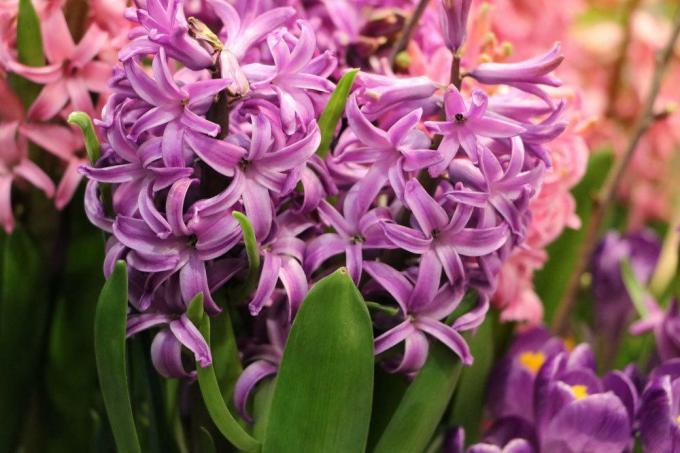
Cherry laurel (Prunus laurocerasus)
The evergreen cherry laurel is often planted as a hedge and shows itself from April to June with delicate flowers in white to cream-beige in small cobs. The leaves are similar to those of a rhododendron. The leaves and seeds in August / September in particular are poisonous parts of the plant that contain cyanogenic glycosides. In order to release the poisonous hydrogen cyanide, a good chewing is required, which makes these poisonous plants particularly dangerous for puppies who like to nibble on everything. No signs of intoxication are to be expected with mere contact. When swallowing without first biting the plant parts, the symptoms usually show up in a weakened form.
Possible symptoms and consequences of poisoning:
- light-colored mucous membranes in the mouth and around the eyes
- Nausea
- Paralysis of the limbs and respiratory tract
- Respiratory failure can result in death
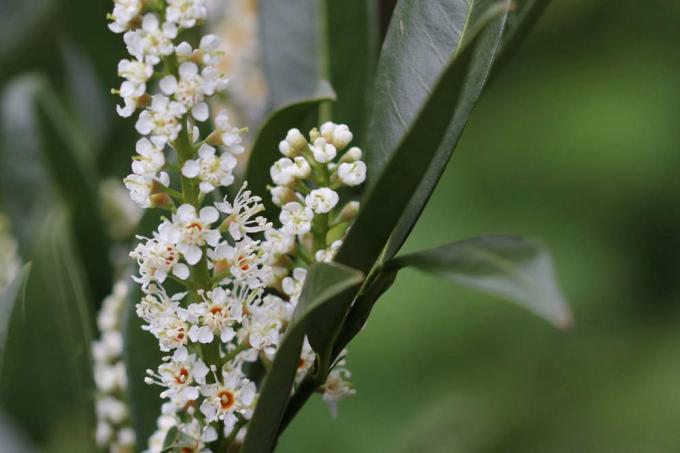
Plants from L to O
Tree of Life (Thuja)
Arborvitae are among the evergreen plants that are popular as trees and hedge. It has flaky leaves and grows as a tree in a natural cone shape with a slim, converging tree top. In autumn they form small cones on the tips of the leaves. Trees of life are particularly common in cemeteries and parks.
They are poisonous plants because they contain a lot of essential oil in some parts of the plant, which can cause poisoning in dogs. Young shoots and shoot tips as well as wooden parts of the plant and the fruiting bodies have a high proportion of essential oil. If your dog nibbles on it, it can have fatal consequences for your four-legged friend.
Possible symptoms and consequences of poisoning:
- strong to very extreme cramps in the stomach and intestines
- severe diarrhea with severe gas
- extreme vomiting
- Irritations of the mucous membranes
- Liver and kidney damage
- Respiratory paralysis
- abortion in pregnant bitches
- Heart failure or respiratory failure resulting in death

Lily of the valley (Convallaria majalis)
From the end of April / beginning of May, the delicate white flowers hang down like small bells on a stem that is bordered by two to three upright leaves. Particularly noticeable is the typical sweet fragrance of flowers, by which lilies of the valley can be recognized immediately. As one of the few poisonous plants it contains several very dangerous toxins: Convallatoxol, Convallatoxin as well as Convallosid and Desglucocheirotoxin. These can be found in the leaves, flowers and fruits.
Possible symptoms and consequences of poisoning:
- Vomit
- diarrhea
- cramps
- Cardiac arrhythmias
- Dizziness, which is manifested by imbalance in the dog
- Circulatory collapse
- with high doses of poison and in puppies death from cardiac arrest possible
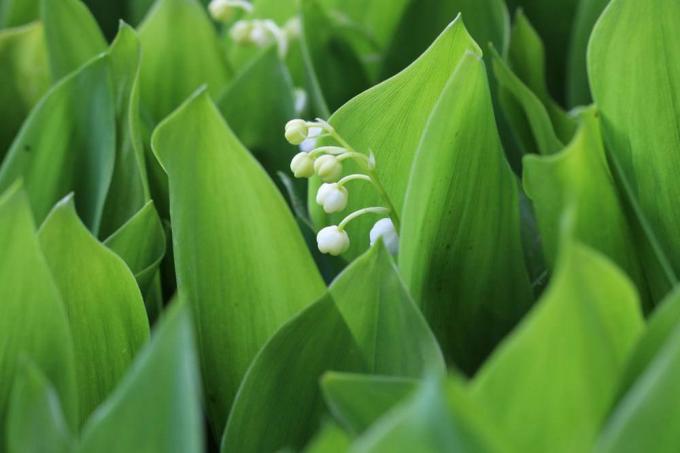
Oleander (Nerium oleander)
The oleander comes from the plant family of the dog poison plants (Apocynaceae), which is no coincidence, because it has poisonous substances that can cause death in dogs. Oleanders are broadly bushy plants with lanceolate leaves and they can reach a height of up to five meters. They even grow wild on the banks of rivers and streams, while they are mainly used in ornamental gardens. The cardiac glycoside oleandrin and nerioside cause poisoning in humans and dogs. They are found in all parts of the oleander plants. The poisons also penetrate the body through open wounds.
Possible symptoms and consequences of poisoning:
- Vomit
- diarrhea
- slowed pulse
- Dilation of the pupil
- cramps
- Blue discoloration of the oral mucosa
- Cardiac arrhythmias
- Cardiac paralysis possible after two to three hours
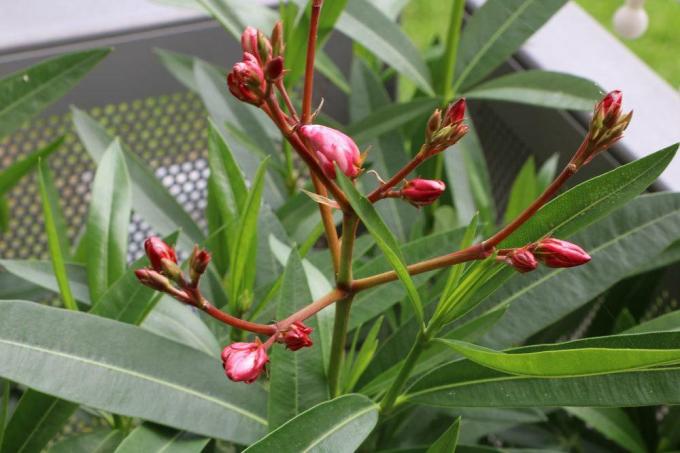
Plants from R to T
rhododendron
There are countless types of rhododendrons, but they all have one thing in common: the laurel-like leaves. The flowering period begins about six weeks after the beginning of spring and ends in August. The flowers are usually in the middle of a wreath of leaves. The rhododendron is one of the poisonous plants with the poisonous substance andromedotoxin, which can only be found in the leaves and flowers of these plants. Andromedotoxin causes immense symptoms of poisoning, especially in immunocompromised dogs, which often lead to death.
Possible symptoms and consequences of poisoning:
- Inflammation of the stomach and intestines
- increased salivation
- cramps
- Paralysis, whereby respiratory paralysis can lead to death
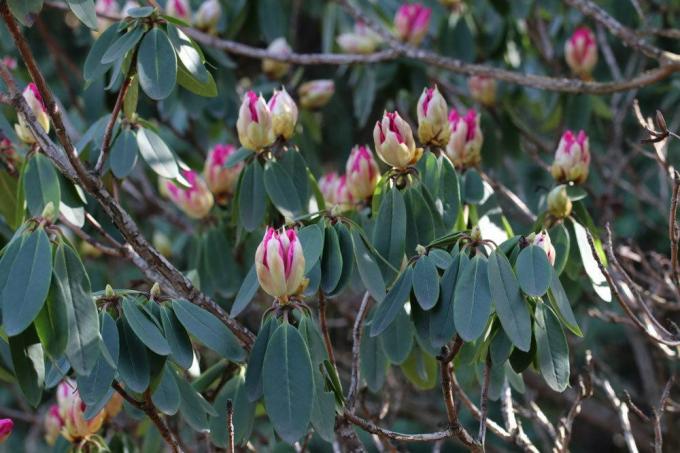
Knight's Star (Hippeastrum)
The knight star is very poisonous for all four-legged friends. Even the smallest amounts are enough to provoke strong symptoms.
Possible symptoms and consequences of poisoning:
- profuse salivation
- diarrhea
- Balance disorders
- Muscle tremors
- in severe cases respiratory failure
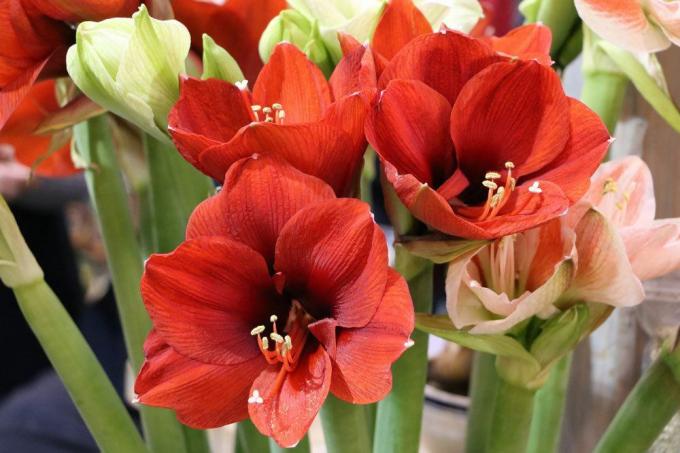
Holly (Ilex)
The palm tree with the small red fruits is particularly well-known at Christmas time, where it is used for decoration. Its leaves are provided with pointed spikes that can be very painful to the touch and even cause bloody wounds. It blooms from May to June and then forms the red fruits. In addition to the leaves, they make holly a poisonous plant for dogs by containing alkaloids.
Possible symptoms and symptoms of intoxication:
- Vomit
- diarrhea
- sleepiness
- From around 20 berries consumed, death can occur
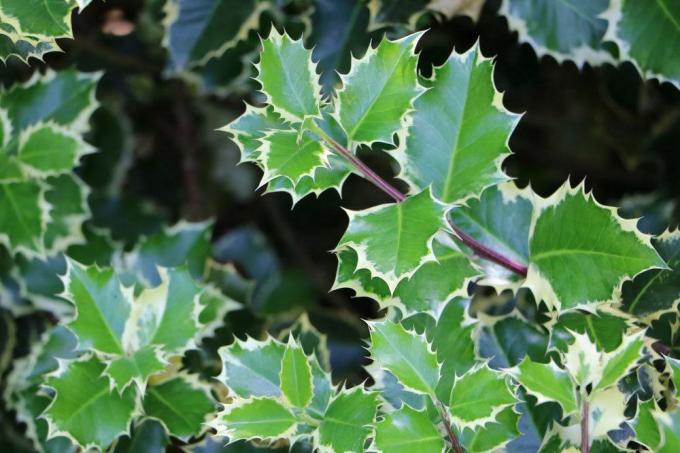
Deadly nightshade (Atropa)
The deadly nightshade usually has almost black, cherry-like fruits between August and October. It grows as a shrub and blooms from June to August with single bell-shaped flowers. It is one of the very dangerous poisonous plants and can kill dogs if they nibble on them. It contains the toxins atropine, scopolamine as well as belladonnin and scopoletin. The leaves are the most poisonous, followed by the roots, seeds and fruits. The flowers contain a small amount of tropane alkaloids.
Possible symptoms and consequences of poisoning:
- dry mucous membranes
- difficulties swallowing
- much thirst
- dilated pupils
- excitement
- Visual disturbances
- constipation
- increased pulse and respiratory rate
- Palpitations
- fever
- Disorders in the sequence of movements
- Fits of rage
- fatal respiratory paralysis (three to four fruit berries can already be fatal)

Tulip (tulipa)
The tulip is one of the most popular plants that usher in spring. They can be easily recognized by their long stems and flower head. They also find their way into living rooms as cut flowers and therefore require double caution when dogs frolic outside and in the house, because tulips are poisonous plants. In all parts of the plants, from the bulb to the stems to the petals, there are so-called tuliposides A and B. as well as tulipin, which allows the tulips to be classified in the list of poisonous plants, although they are "only" slightly poisonous is. However, small puppies can experience more severe symptoms and the effects of poisoning.
Possible symptoms and consequences of poisoning:
- Skin and mucous membrane irritation
- Itching on skin contact
- Gastric and intestinal irritation
- Stomach cramps
- Difficulty breathing

TIP: No matter whether you suspect or are certain that your dog's plant parts are one of these has / could have eaten the poisonous plants listed, you should not hesitate to contact the vet immediately to contact. Depending on the severity of the poisoning, every minute can determine the severity of the consequences of the poisoning.
